Daniel M. Bensen's Blog, page 52
March 22, 2018
Swiftly Falling Snow
Swiftly falling snow
Covers and changes the streets
Though each flake is small

March 20, 2018
Snow on Green Leaf Buds
Snow on green leaf buds
cannot last under the sun.
Soon they will open.

March 15, 2018
The Three Seas
Not many words today. You have to look at things. Like this. LOOK AT THIS!
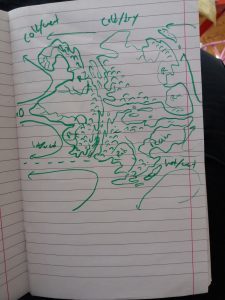
I was thinking about a Mediterranean-type sea, but with three outlets to the world ocean rather than two. Our world has the straits of Gibraltar into the Atlantic and the Bab el Mandeb (via the Red Sea) into the Indian Ocean. The Med also connects to the Black Sea, but the Black Sea has no connection to any ocean. I actually experimented with making one…
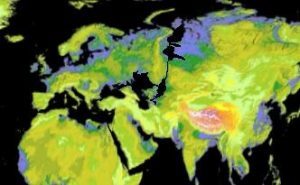
But it lacks a certain…good…ness. It’s not good, is what I mean.That long north-south river thing? That’s dumb.
So I made up some new continents! Imagine three continental plates, two sitting placidly while a third slams into them from the side. It will push both other plates north and south, opening the gap between them. Eventually the mountains thrown up by the collision will close the gap between one or both of the old continents and the new one, but for a while, there will be three seas with a meeting point right between the three continents.
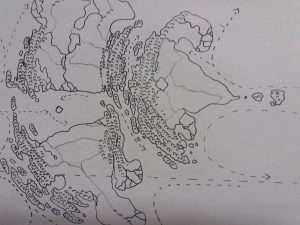
Also I flipped the whole thing east-to-west. Don’t want it to look too much like Europe, Asia, and Africa. These are three new continents! Sacima in the northwest, Phoucia in the southwest, and…uh…Visacia in the east. Now. What sort of people live here?

Five Star Reviews: Aggressor Six
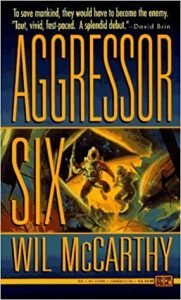
Aggressor Six by Wil McCarthy
I missed a nap for this book, dammit! I stayed up all afternoon after an exhausting trip to the children’s museum because otherwise how would I learn why the aliens blew up all those space colonies and what form the main character’s mental illness would take. Could they be related??
Aggressor Six is a tight, well-contained story with expansive world-building and intense emotional resonance. The book follows a severely traumatized space marine in his mind-bendingly difficult task of understanding and predicting the behavior of the aliens threatening Earth. There’s mystery (what do the aliens want?) and tension (is this guy ever going to be allowed to heal?) set in a world that we don’t get to see much of, but which feels gratifyingly vast. The aliens don’t make many appearances, but when they do, their biology and psychology work. The spacecraft and super science are not the subjects of multi-page info-dumps, but what we do know makes sense and is consistent. The characters don’t go on and on about the future history of humanity, but throwaway lines (“boy, those Clementines must have had some wild parties”) tell us an interesting and believable story behind the story of, you know, the destruction of the Earth. And the answers to the big questions hit just the right note of expected surprise.
I suppose I could quibble about the characters. What were their names again? The ending was abrupt, and the love story did need developing. But I had fun reading Aggressor Six. I couldn’t stop reading it, in fact, until it was over. What’s more, the story is staying with me.
There is a theme here (and in other books by Wil McCarthy) of racing against time to prevent an unimaginably huge calamity, and the procedural myopia we develop under such circumstances. An alien fleet heading toward us? Buckle down, everyone, and build more laser guns! Train harder! Sleep less! Don’t waste time on chit-chat move move move! Anyone who has experienced a panicked rush like this knows that it causes more damage than it fixes. The implacable advance of death doesn’t demand that we stop having feelings. Precisely the opposite in fact.
Read Aggressor Six for a gripping story of what makes us inhuman.

Snow Melts into Mud
Snow melts into mud
Uncovers garbage and seeds
On gray ground, green shoots

March 8, 2018
Magic Monkeys
So I’m listening to The Blood of Elves and thinking about breeding magical ability and the The Wheel of Time and all that, and I realized that I’ve never seen anybody go into the population genetics of magic.
What if there was a single mutation, call it Mutation X, that produces a gene (Gene X, obviously), which produces and enzyme that channels energy from the 13 dimension into heat? What would you get?
Exploding babies. That’s what you’d get. Not very advantageous. Especially since they’d probably take our their families too.
Alright, but what if enzyme x only works in neurons, and only when the neurons are linked in a large and dense network that is undergoing very specific activity?
Exploding heads.
I thought of some mutations that might tone down the tendency to explode, but in order for them to have enough time to evolve in the first place, I’d need to start out with a weaker form of Enzyme X, which would take more time to evolve to the point where you could use it to throw fire at people.
So that’s what I did
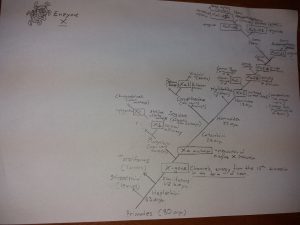
an unwashed jpeg for you unwashed primates!
Our story begins in early Oligocene, when the X Gene first appears in a basal simiiform (the ancestor of monkeys, apes, and humans). After a substantial metabolic investment reaching and sustaining the a particular state of cortical activity, these monkeys were rewarded with heat. This mutation allowed them to survive colder environments, which gives magic monkeys a wider range than real-world monkeys. That causes some interesting things to happen in Antarctica, but otherwise doesn’t effect the course of history much.
Mutations that up-regulate Enzyme X production or improve the efficiency of either the enzyme or the cortical structures that trigger it pop up regularly. The problem is that raising the brain above 100 degrees c will kill any monkey that tries it. Various solutions evolve, such as living in cold water (don’t swim around Antarctica), or restricting magic-use to parthenogenic clones (don’t go into the baboon-hive). But then apes evolved bigger brains.
Hominids (orangutans, humans, and everything in between) developed the brains to project the energy dump outside of their brains, allowing them to raise the temperature of an arbitrary patch of air to 100 degrees or even higher. This ability was enormously beneficial, but also dangerous. Mutations that decreased Enzyme X production became fixed in orangutans, who have controlled but weak fireballs. Other hominids have delayed onset of enzyme X expression until puberty. Chimpanzees and hominins have an additional mutation, which makes the magical mental state painful, and relegates its use only to dire situations. This made enzyme X safe enough to allow up-regulating mutations to spread, especially in Eurasia.
Australopithecus evolved one potent form of enzyme X, which allows them to cause explosions anywhere in their visual range. Especially on the Eurasian step, they are deadly predators, and we call them “goblins.”
African Homo hominins evolved up-regulation separately as they migrated north. Homo erectus are less magical powerful, but more intelligent than goblins, although incapable of speech. We call them “elves.” H. neanderthalensis (“dwarves”) and H. sapiens share another up-regulation mutation, but it seems the last mutation was in humans alone. For us, the X-gene is recessive. This allows up-regulatory and pro-efficiency genes to accumulate in heterogeneous individuals, where they can do no damage. And for every cottage hut that explodes, there’s another with a sibling who makes sure the meat is always well done.
It has turned out to be a stable equilibrium. 75% of humans have no more magical ability than a tarsier, but the remaining 25% can, after puberty, and at the cost of intense pain, raise the temperature of anywhere in their visual field into a furnace hot enough to melt lead. There are rumors of elf-human hybrids who can melt iron with their minds.
So that’s fun.

March 7, 2018
The Branches are Bare
The branches are bare
But I can still imagine
Past snow and spring leaves

Haiku 3
The branches are bare
But I can still imagine
Past snow and spring leaves

A Blanket of Smog
A blanket of smog
Warm and cold exchange places
It’s Mount Vitosha!

March 1, 2018
The Duties to the Gods of Pto’a
Tonun-uva Shyamuga kozana, maanun kromma huttun-osha amaanna.
Khrhaashora ‘on wamanokha-nash shkaf-nash ‘on om’an-natosha ‘on Hagopa-na-natosha an ‘on mula-tosha ‘on Hunabura-natosha.
If we are to obey Beautiful Shyamuga(1), we build temples to pray (in) them.
Only the lazy ones flee toward the lands of the Hagopas(2) and the deserts of the Hunaburas(3).
Tonan-uva Shoshka kona, onran ‘otna knon-osha ugana.
Khrhaashora ‘on khrhashokha-nash shkaf-nash ‘on om’an-natosha ‘on Nobana-na-natosha an ‘on tsonaght-tosha ‘on Kkekkanna-natosha.
If we are to obey Mighty Shoshka(4), we convene armies to fight Ugas(5).
Only the cowardly ones flee toward the lands of the Nobas(6) and the wilderness of the Kkekkans(7).
Tonan-uva Takheshpa khushohaa, maamanun seghana orun-osha pona.
Khrhaashora ‘on abhokha-nash shkaf-nash ‘on tsoda-tosha ‘on Nuhana-tosha.
If we are to obey destructive Takheshpa(8), we endure inundations to eat corn.
Only the greedy ones flee toward the lake of the Nuhas(8).
Oshoba wamanokhana! Oshoba khrhashokhana! Oshoba abhokhana!
Ovha-wora ‘on padaahana Pto’a-nosha ovaashna!
Go, you lazy ones! Go, you cowards! Go, you greedy ones!
The gods of Pto’a(9) do not want you!
— ‘On tontna ‘on padaahana-nosha Pto’a-nanosha
– The Duties to the Gods of Pto’a
(1) A sun god, related to Hurrian Šimegi.
(2) The Ucaptians, from Ucaptian ħwt k ptħ, or “house of the soul of Ptahh.”
(3) Presumably a nomadic people in northwestern Africa. Possibly the same as the knj-brw mentioned in Ucaptian sources as dwelling in the Atlas Mountains.
(4) the war goddess, related to Hurrian Šauška.
(5) The Hittites, from Hittite ekku, or “horse.”
(6) The Nubians, from Nubian Noba.
(7) Presumably a nomadic people in east Africa. Possibly related to Old Wak’ang apuok’e!in, or “correct.”
(8) A Eunymphic people, probably the proto-Taynadzians. Compare Taynadzian nùh, or “people.”
(9) The Classical name of the Kingdom of Podzra, from Ancient Podzran Patahhai.




